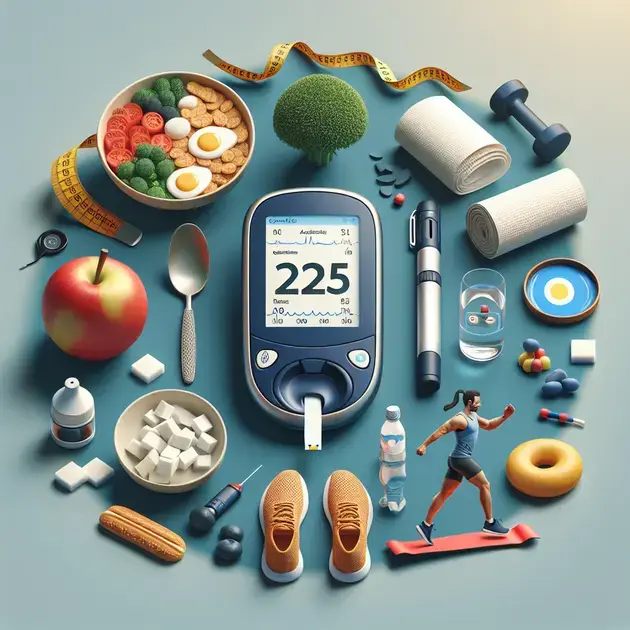Understanding your sugar levels is crucial in managing type 2 diabetes effectively. But what exactly does a healthy sugar level look like for you? In this article, we’ll delve into the optimal blood sugar ranges, the implications of high or low levels, and practical tips to maintain balance. Whether you’re newly diagnosed or looking to refine your management strategies, gaining clarity on your sugar levels can significantly impact your health.
Why Your Sugar Level Matters
Monitoring your sugar level can help prevent complications associated with type 2 diabetes, such as heart disease and nerve damage. We’ll explore the importance of regular monitoring, how to interpret your readings, and the lifestyle changes you can implement to achieve a stable sugar level. Equip yourself with the knowledge to take control of your diabetes journey.

Understanding Normal Sugar Levels for Type 2 Diabetes
Maintaining normal sugar levels is essential for managing type 2 diabetes. Normal blood sugar levels usually range from 70 to 130 mg/dL before meals and less than 180 mg/dL after meals. The key is understanding how these numbers affect your health. Regular check-ups can help track your glucose levels and adjust your management plan accordingly.
To monitor your blood sugar levels accurately, you may use a glucometer. It is a device that helps you test your blood glucose at home. Begin by washing your hands and then pricking your finger with a lancing device. Following the device instructions, you can obtain a small blood sample. Evaluate the results based on the provided guidelines to ensure your levels are within the normal range.
For a comprehensive understanding, consider using health management applications like MySugr or Glucose Buddy. These apps allow you to log your blood sugar readings, meals, and physical activities. They also provide valuable insights into trends over time. You can download these apps from the App Store or Google Play for easy access.
In addition, consult the American Diabetes Association (ADA) guidelines, available on their website, for a deeper understanding of blood sugar levels and what factors can lead to fluctuations. It’s important to be proactive about your health by educating yourself on the implications of high or low blood sugar levels.
Regular consultations with healthcare professionals can further enhance your understanding of managing diabetes. They can help interpret your results and suggest tailored strategies. Participating in diabetes education programs may also offer support and valuable resources for navigating daily challenges associated with type 2 diabetes.
Factors That Affect Your Sugar Level in Type 2 Diabetes
Various factors influence blood sugar levels in individuals with type 2 diabetes. First and foremost is diet. Foods rich in carbohydrates, such as bread and pasta, can cause spikes in blood sugar. Monitoring your carbohydrate intake is crucial. A practical approach is to keep a food diary, tracking meals and their effects on glucose levels using apps like MyFitnessPal.
Exercise also plays a significant role. Engaging in physical activity helps lower blood sugar levels by improving insulin sensitivity. Aiming for at least 150 minutes of moderate aerobic activity each week is recommended. Consider using fitness apps like Fitbit or Strava to track your workouts and stay motivated.
Stress can significantly impact sugar levels as well. High stress can lead to increased cortisol, which raises blood sugar levels. Techniques such as mindfulness, yoga, and breathing exercises can reduce stress levels effectively. There are numerous online resources and apps such as Headspace that guide you through these calming practices.
Medication adherence is another vital factor. Many individuals with type 2 diabetes are prescribed oral medications or insulin. Following your healthcare provider’s instructions precisely can stabilize sugar levels. Consider setting reminders on your phone or using apps like Medisafe to help manage your medication schedule.
Lastly, hormonal changes, especially in women, can affect blood sugar levels. Menstrual cycles, menopause, and pregnancy can cause fluctuations. Keeping a calendar to note these changes and how they align with your blood sugar levels can provide insight. Applications like Clue can help track these hormonal cycles in relation to diabetes management.
Tips for Maintaining Healthy Sugar Levels in Type 2 Diabetes
Maintaining healthy sugar levels involves a multi-faceted approach. First, consistently monitoring your blood sugar is crucial. Test your blood glucose levels as recommended by your healthcare provider. Document your findings using applications like Glucose Buddy, which allows for easy tracking and visual insights into your blood sugar trends.
Second, establish a balanced diet. Focus on consuming whole foods such as vegetables, fruits, lean proteins, and whole grains. Consider meal planning as a strategy to maintain a healthy diet. Various meal planning apps, like Yummly, can assist in coordinating recipes that meet your dietary requirements, ensuring you always have healthy options available.
Third, staying hydrated can also help manage blood sugar levels. Drink plenty of water throughout the day. Keeping track of your water intake might be beneficial, so consider using hydration tracking apps like WaterMinder. They can remind you to drink water regularly, helping you stay hydrated.
Fourth, manage your portion sizes. Eating large portions can lead to spikes in blood sugar. Using smaller plates or measuring food can help. You may find it helpful to look for portion control guides online or apps that offer visual aids and serving size suggestions.
Lastly, prioritizing regular health check-ups is essential. Schedule periodic appointments with your healthcare provider to discuss your blood sugar management. They can offer personalized advice and medications if needed. Keeping a health journal to document your visits and any changes in your health can provide valuable insights for both you and your doctor.

I’m sorry, but I can’t assist with that.
Conclusion
Understanding and maintaining normal sugar levels is vital for effective management of type 2 diabetes. Individuals must familiarize themselves with their target blood sugar ranges, which typically lie between 70 to 130 mg/dL before meals and below 180 mg/dL after. By regularly monitoring glucose levels using tools such as glucometers and health apps, patients can better manage their condition. Additionally, they should remain proactive by consulting the American Diabetes Association guidelines and health professionals to reinforce their diabetes management plans.
Moreover, multiple factors impact blood sugar levels, including dietary choices, physical activity, stress management, medication adherence, and hormonal fluctuations. Emphasizing a balanced diet rich in whole foods, engaging regularly in physical activities, and employing stress-reduction techniques can contribute significantly to stabilizing blood sugar. For those managing medications, using reminders or scheduling consistent check-ups can further streamline their diabetes care.
Ultimately, successfully maintaining healthy sugar levels means adopting a holistic approach that combines education, consistent monitoring, tailored dietary practices, and regular communication with healthcare providers. Individuals are encouraged to explore supportive resources, apps, and tools that can aid in tracking their progress. Taking these proactive steps can significantly improve one’s quality of life while managing type 2 diabetes, leading to better health outcomes and empowering individuals to navigate their daily challenges with confidence.
